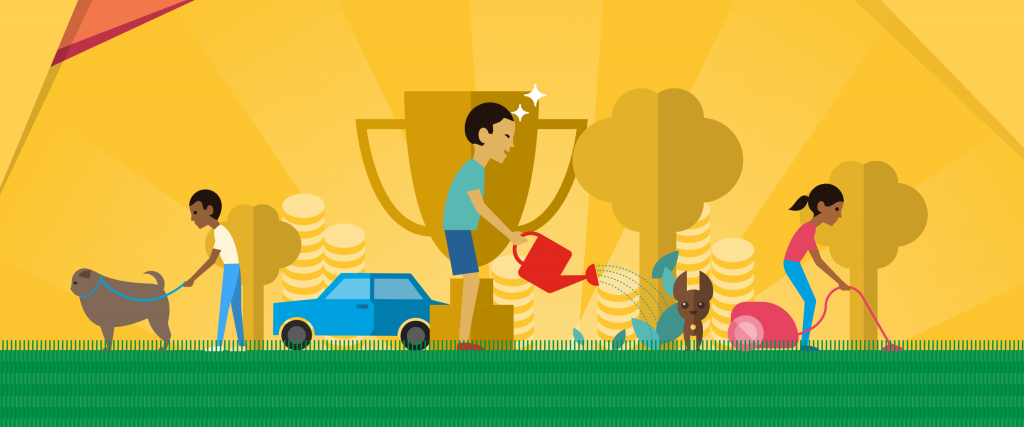What’s on this page?
-
Introduction to teaching children about money
-
Talking to kids about money
-
Pocket money
-
Pocket money routines
-
How much pocket money to give
-
-
Using chores for kids as an educational tool
-
Reward chart systems
-
Money activities for kids
-
Integrating lessons into the everyday
-
Arts and Crafts activities
-
Money activities at home
-
Introduction to teaching children about money
In this post we break down some of the key areas involved in teaching children about money. It’s a vast subject, but also an increasingly important one. RoosterMoney itself was created to help address the area of teaching children about money. We started it for many reasons, but one of the key drivers was that low financial literacy levels are a global issue (the latest OECD PISA global study found that 1 in 4 students aged 15 are unable to make simple decisions on everyday spending), and the changing world of money in our increasingly cashless society, are making it harder than ever to pass on basic financial principles, and good money habits, to the next generation.
In our experience, having spoken to financial experts, child psychologists, bankers, teachers, and most importantly parents and kids themselves, what we know for sure is that every child is different and every family has a different approach to money. When it comes to teaching children about money there isn’t much commonality between the success stories, save for two areas:
- An openness to talking about money within the family,
- And being as consistent as possible with any routines that are set up
There are of course many more areas to consider, like when to start, how much to give, and whether you should pay for chores and grades. But these things will all depend very much on you and what works for your family. So have a read of our tips and feel free to pick and choose what feels right for you.
Talking to kids about money
Talking to kids about money, and more specifically, having positive conversations about money with your children from an early age, is probably the most important thing you can do as a parent when it comes to instilling good attitudes towards money.
A study by the Money Advice Service with Cambridge University showed that parents talking to their kids about money was the key influence on their money habits later in life. Bearing this in mind, one of the main considerations when building RoosterMoney was how we could remove some of the typical barriers associated with pocket money routines, in order to create space for those positive conversations.
But once you’ve created that space, how do you have those conversations? To give you an idea of the types of topics you might want to start with Young Enterprise have a fairly comprehensive list of subjects to tackle. And luckily for you, we’ve written a whole series of Primers on how to talk about money with your kids covering all subjects from distinguishing between needs and wants, to explaining interest rates. We’ve also broken the subjects down by age group as a rough guide, but every child is different so start at the beginning and work your way through as you feel appropriate. In terms of what age to start, some say that as soon as a child is old enough to know not to put the coins in their mouth they’re old enough to start learning what they are, but it’s whatever you feel comfortable with.
If you’d like to explore the area of talking to kids about money further, feel free to check out our Primers.
Pocket Money

-
Pocket money routines
Routines are the second golden rule of teaching children about money. We understand kids don’t always like routines, but trust us, if the routine entails them getting some money and you not forgetting how much you owe them all the time, they’ll absolutely love it. And when it comes to instilling good habits, children thrive on routine.
And what better routine to start than a pocket money or allowance routine. Something we’re all familiar with, many of us will have received pocket money as a child, and some of us may have already attempted a pocket money system with their kids. If you have, you’ll know it’s not easy. Whether it’s the fact you can’t keep track of what they’ve earned, or what you owe them, or that you simply don’t have the coins to hand over on pocket money day every week – what should be quite simple, can often become cumbersome. If this sounds like you, then our RoosterMoney app will alleviate many of those issues and free up space to have more positive conversations about money with your child.
As pocket money is most children’s first introduction to money (along with the tooth fairy of course), it’s the perfect way to start introducing some of those basic money principle like saving spending and sharing. The key things to consider, beyond just how much to give, are what conditions you’re going to attach to the money, if and how they’re going to earn it, and being strong enough to say ‘when it’s gone it’s gone’. If you’ve decided to start a pocket money routine, but aren’t quite sure where to start you can check out our top tips on starting a pocket money routine that will help teach kids the value of money.
-
How much pocket money to give
How much pocket money or allowance to give is the next big question to answer. For fear of sounding like a broken record, everyone’s different. But we firmly believe pocket money doesn’t need to be expensive, whether you give 20p or £20 a week, the lessons are the same. Having said that, knowing what other parents give is always a helpful indicator (and sooner or later you’ll find out from your child how much their friends are getting!) so we’ve pulled together the Pocket Money Index which offers a glimpse into how much pocket money children are getting across the country. It also reveals the wider picture of what chores the kids are doing, what they’re spending their money on, what they’re saving for and more. There’s also the classic £1 per year rule, so a four year old gets £4 and a 10 year old gets £10. But whatever amount you choose you have to decide what it’s for, £10 a week might sound a bit much if it’s just for sweets, but if they’re expected to chip in towards their Spotify account and Magazine subscriptions then maybe it’s not that much all of a sudden.
Using chores for kids as an educational tool

One of the most hotly debated subjects in the world of teaching children about money is whether or not to tie pocket money and allowance to a chores or a chore system. There are two basic camps here, a. Yes you should, as it helps them understand that you need to earn your money, and b. No you shouldn’t, an allowance should be a teaching tool to help children learn to handle money, and besides chores should be done for free by every member of the family (a case made by Ron Lieber in hist best seller The Opposite of Spoiled)
Within this there is also the choice of whether to set a bulk of chores as the criteria to ‘unlock’ an allowance, or whether to ‘pay-per-job’. And do you remove money for chores not completed? Oh what a minefield.
There is of course a third way, where you take a bit from each camp. You have certain chores that are expected as being a member of the household, and then specific extra jobs that carry extra rewards, say for examples, raking the leaves in the garden, or helping wash the car.
Whichever way you choose, make sure you’re clear on the rules, and stick to them. The more times you pay the allowance in spite of unfulfilled chores, the weaker the lessons will become. Another scenario to avoid is one where your child all of a sudden refuses to do his chores, as he’s reached a level of pocket money he’s happy with and therefore sees no reason to unload the dishwasher today.
To help you navigate such unexpectedly complex territory we’ve pulled together the most common chores for kids on RoosterMoney, and the most lucrative ones, and broken it all down by age as well. All of which should help you come to an informed decision.
And in the next few weeks we’ll be looking into the subjects of whether to pay for good grades and homework too.
Reward chart systems

Reward charts are a great to way to start teaching some good money habits at a very early age. The first money related lessons we need to learn as children are around delayed gratification (understanding that patience and time can result in a greater reward), and opportunity cost (understanding that choosing to do one thing results in not being able to do another). Both of these lessons are at the core of a reward chart, and even better, you don’t need to use money at all, you can simple use stars, or ticks in a box – which is what makes them ideal for younger kids. If for example they need to brush their teeth every night for get a star at the end of the week, that’s delayed gratification. If for example, they choose to cash in their one star for an ice cream, instead of waiting to build up two stars which could get them a new toy, that’s opportunity cost. Ta-dah!
Star charts are super easy to make from scratch with some paper and crayons, or you could use our ready made customisable reward chart template here. Or, even better, within RoosterMoney you can set the currency to ‘stars’ which effectively turns the app into a reward chart and you’re ready to go.
Money activities for kids

At any age, the ‘learn by doing’ mantra rings true, but for kids even more so. Our app is designed to help parents capitalise on those everyday teachable moments that crop up, (like when they want that magazine on the shelf with the plastic toy on the front that you know they’ll never read), but sometimes you may want force the issue a bit more, which is where these money activities for kids can come in useful.
-
Integrating lessons into the everyday
Integrating the lessons into everyday life is still a great idea, so if you’re planning a trip the local charity shop, get them involved in choosing the items and discussing how charity shops work (learn more). If you’re looking to switch your utility bills, ask the kids to help you find cheaper rates on comparison sites. When on the weekly shop, set them mini challenges to find the cheapest peanut butter, pointing out the cost-per-unit information on the labels (learn more).
The school holidays are a great opportunity to try some more ambitious activities, especially the Summer Holidays where there can be a lot of time to kill. Check our a Summer tips for teaching children about money here, including planning a BBQ together from budget, to shopping list, through to beautifully burned sausages. The Spring Clean is another great opportunity to try things like a yard sale which can not only help declutter the house but also teach some valuable lessons. And last but not least, the Christmas break is prime time to put some of those money lessons into practice.
-
Arts and Crafts activities
If you’re in the mood for something more hands on, you can check out the ideas we dreamt up with toucanBox for more arts and crafts style educational money activities, including designing your own £20 note and organising a family dinner party, menus, placemats and everything!
-
Money activities at home
Of course, getting the masking tape and paint brushes out isn’t to everyone’s taste, some prefer to sit and absorb from a good book. So we’ve pulled together the best money book for kids out there. And once they’ve been inspired why not see how they do with our Money Matters course, a free printable set of activity sheets developed with Children’s University.
So there you have it, our guide to teaching children about money. By no means an exact science, but keep talking about it with your kids, stick to your routines, and have some fun with the activities above and you’ll be off to a good start.
Got any ideas or suggestions for what we cover next? Let us know at hello@roostermoney.com and it might get featured in a future blog!